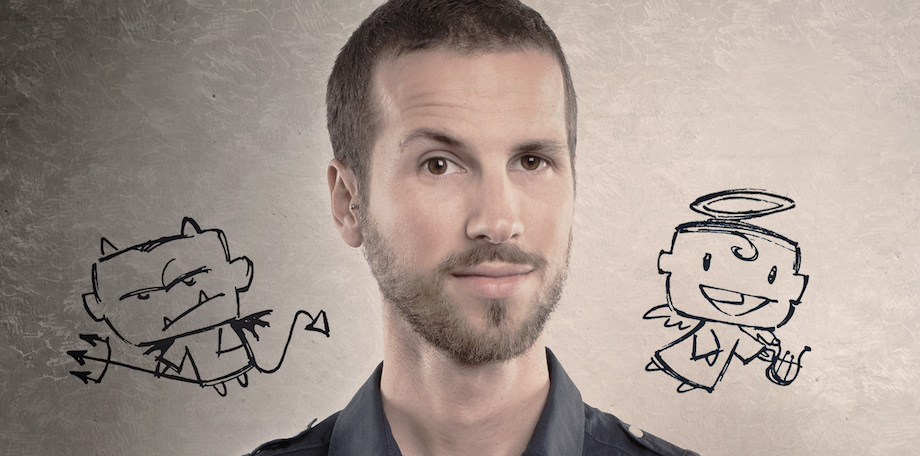Caroline described herself as a “serial job hopper.” She had trouble staying with a job for more than a year, complaining of difficult bosses, unfair workloads and annoying co-workers …
Alex enjoyed fatherhood when his twins were younger, but struggled to connect — and usually, even to get along — with them now that they had reached their teen years. He wondered where he went wrong …
Sara knew that she had gained a lot of weight over the past couple of years, but didn’t realize how serious it was — until her doctor warned her that she was pre-diabetic. She had a health club membership, but rarely found the time to use it. And diets only frustrated her …
In pursuit of our goals, including the “seemingly simple” ones — to feel self-confident, to be content with our lives, to enjoy satisfying relationships and to achieve career success — we often stand in our own way. Most of the time, we don’t even realize it. Fortunately, by increasing your awareness, you can begin overcoming self-limiting beliefs and self-imposed obstacles.
7 ways to stop self-sabotage
Caroline’s decision to quit a job any time the road felt a little bumpy was both influenced by — and resulted in — self-defeating thoughts and behaviors. Rather than solving challenges by exploring solutions, Caroline jumped ship. Self-sabotage can take many forms. Following are a few of the most common ways you might be acting as your own enemy — and what you can do to be a better friend to yourself instead.
1. Recognize distorted thinking patterns.
On average, about 60,000 to 70,000 thoughts run through your head per day. What’s more, approximately 90 percent of those thoughts are the same as the ones you had yesterday.
These thoughts are so powerful that they become the basis for your “mental playlist” — usually without you realizing it. They become the stories you tell yourself, not only about your strengths and weaknesses, but also about the way the world operates. And because self-dialogue is like a running ticker tape, over time, you begin to believe these stories.
The problem: many of them are false!
These thoughts become the stories you tell yourself, not only about your strengths and weaknesses, but also about the way the world operates.
Because your thoughts drive your moods, influence your behavior and impact your results, developing the self-awareness to recognize when those thoughts are flawed is critical.

Alex was so caught up in his negative thoughts about his relationship with his sons that he created “stories” that held him back from making any efforts to improve it. “They never want to hang out with me anymore” prevented him from asking them to go see a movie, join him for a run or try the new pizza place.
Also called cognitive distortions, distorted thinking patterns take many forms and often overlap. A few of the most common include:
- All-or-nothing thinking — Putting situations or assessments in absolute terms, all-or-nothing thinking (also called black-and-white thinking) fails to recognize the middle ground. Examples of tip-off words include always, never, only and all/every — as in, “I’m always last on the list” or “He never recognizes my efforts.”
- “Shoulds” — Words like should, ought or must imply that there is a right and wrong way of doing (or saying/thinking about) something. Telling yourself that you “should” be earning a six-figure salary at this stage of your career is inherently critical if you’re not.
- Labeling — Assigning a label to yourself or others (e.g., “I’m a loser,” or “She’s a control freak”) based on a single situation — or perceived shortcoming — is the result of overgeneralization, colored by an element of judgment.
- Mental filter — When you hone in on one negative aspect of a situation, overlooking all the positive ones, you could be using a mental filter. Example: your employee review is mostly positive; your boss says that you “exceed expectations” in every category — except innovation. You berate yourself for not being more creative and wonder if your boss questions your value to the team.
- Catastrophizing — When you assume that one negative event will result in a disaster, you magnify its significance. If you bomb a client presentation, and are overcome with anxiety over losing your job, wondering then how you’ll pay the mortgage … send your kids to college … be able to live comfortably in retirement … you could be catastrophizing.
Once you develop this awareness, you can catch yourself when these self-limiting thoughts pop into your inner dialogue — and adjust them accordingly.
2. Ease up on the self-reproach.
Wishing we had done something differently in the past isn’t inherently negative; how we frame it in our minds — and what we do about it — is pivotal. While self-reproach can involve distorted thinking (it’s easy to label yourself a “loser” when you fail a test — or experience a failed relationship), the ramifications of self-reproach can be even more dangerous.
When we don’t reconcile the thoughts that result in guilt, shame or regret, the self-imposed emotional bruises they create can be hard to heal, resulting in detachment, anxiety and even depression.
What’s the difference between guilt and shame? One of the primary distinctions between guilt and shame is that the latter encompasses more judgment — either of yourself or others’ perceptions of you. Best-selling author Brené Brown, a professor at the University of Houston Graduate School of Social Work, defines shame as an “intensely painful feeling or experience of believing that we are flawed and therefore unworthy of love and belonging — something we’ve experienced, done, or failed to do makes us unworthy of connection.”
Shame, she says, has the potential to lead to destructive and hurtful behaviors, stemming from a fear of disconnection. Guilt, on the other hand, isn’t inherently negative; used constructively, it can actually help you act in greater alignment with your values.

3. Ditch perfectionism.
Perfectionism is often a manifestation of fear: fear of failing, disapproval or upsetting others. Because it creates stress, perfectionism can actually work against you, preventing you from trying new ways of doing things or taking risks to initiate change.
In Sara’s case, going to the gym three times a week was “good enough;” it was better than going zero times a week, and it broke her pattern of inertia. Within a month, she had dropped a few pounds, but more importantly, she had gained self-confidence in her ability to stick with a program. In the words of John Steinbeck, “And now that you don’t have to be perfect, you can be good.” While nobody strives for mediocrity, being OK with “good” can be very empowering.
4. Find — and use — the right tools.
If you don’t have the right tools at your disposal — or you neglect to use them — you could be setting yourself up for failure. If your “tried and true” system for managing your To-Do list isn’t working for you anymore, for example, you might want to explore the plethora of new productivity apps that have become available over the past few years.
Top chefs recognize the importance of mise en place, which involves having all your ingredients lined up and ready to go before assembling a recipe. Embraced in the culinary world, the concept has applications that extend beyond the kitchen.
Knowledge can also be a tool. Alex found several parenting books that helped him understand his kids’ behavior in context. After learning that his kids were displaying developmentally appropriate behavior (and attitudes), he stopped taking it personally. As a result, he was able to adjust his parenting style — and to develop a healthy relationship with his sons.
Most of us are pretty good at following through on commitments to others, but fall short on the promises we make to ourselves.
5. Prioritize your own needs.
Many people have trouble saying “no.” Whether it’s a request to volunteer on a fundraising committee, bake for your child’s end-of-the-season soccer picnic or spend a Saturday afternoon quizzing a co-worker before she takes a licensing exam, it’s easy to justify taking time away from your own needs.

Most of us are pretty good at following through on commitments to others, but fall short on the promises we make to ourselves. Putting yourself first can feel selfish. But like a battery, you won’t be much help to others if you’re drained. Prioritizing self-care can profoundly reverse the cycle of self-sabotaging beliefs and behaviors.
6. Slow down.
Multi-tasking is a myth. Busyness is overrated. Rushing often leads to mistakes. In trying to get it all done, we often compromise quality, not just in our work, but also in our personal lives. If you’re going out for a walk, enjoy the scenery. If you’re working, silence your cell phone. If you’re having dinner with your significant other, fully engage in the conversation. Incorporating a mindfulness practice — like this “Three-Minute Breathing Space Practice” — is one way to reset your focus on the present.
7. Invite — and accept — support.
When Sara’s sister listened to her story over the phone, she refused to feel sorry for her — and to perpetuate the “story” that Sara had created about her weight. Instead, she decided to give Sara an early birthday gift: three sessions with a trainer at her health club. While the trainer couldn’t do the exercises for Sara, he was able to teach her how to use machines and free weights safely and effectively, familiarize her with several new exercises and, perhaps most importantly, provide her with emotional support.
Caroline decided to seek career coaching services to help clarify her professional goals — and, in the process, learned how to overcome the self-defeating thoughts and behaviors that stood between her and a satisfying career.
Whether you hire a professional coach or trainer, join an organized support group or attend a workshop, finding the right type of support for your needs can be a game changer. Through objective insights, information and motivation, support systems facilitate change — and can provide you with the push you need in order to get out of your own way.

